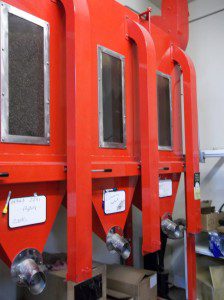22 Jan Behind the Scenes: Coffee Roasting at Pasquini
Ever since I lived in Italy, a daily cappuccino is a part of my every day routine. Each morning, I grind the beans and steam the milk to make my own cappuccino. I have owned a variety of Italian espresso machines over the years and my favorite has become the Pasquini. While the machines come from Italy, I learned recently that Pasquini is based in the US, actually right here in Los Angeles! I took a trip to the showroom that is located on Olympic Blvd, just west of Downtown LA, for a behind the scenes tour. When Ambrose Pasquini moved to Los Angeles in 1951, he missed his daily espresso(s) that is a common experience in Italy. So, he imported an espresso machine from Italy and opened Moka d’Oro on Vermont Blvd., the first espresso café in Southern California. As other restaurant owners expressed interest in the machines, he began importing machines and adapting them to American standards and adding improvements, such as pressure and temperature controls. Then, in the 1970s, Mr. Pasquini designed an espresso machine for home use. Five decades later, Ambrose Pasquini still runs the family business with his sons Guy and Matthew.
A great espresso machine needs great espresso
In addition to importing and selling espresso machines for commercial and personal use, Pasquini roasts their own coffee for commercial sales. The roasting warehouse is located behind the showroom and I was given a behind the scenes tour of the roasting process.
Before arriving to Pasquini, or any coffee bean roaster, here is a short summary of where coffee comes from. A coffee bean is actually a seed. It takes approximately 3-4 years for newly planted coffee trees to begin to bear fruit, called the coffee cherry. When ready to be harvested, the fruit turns a bright, deep red color. Once the coffee fruit has been picked, it is processed, dried and milled. When milling the beans, the parchment layer is removed from the coffee and then polished. The coffee is then graded and sorted by size and weight. Once milled, the beans are referred to as ‘green coffee,’ and are ready to be exported.
When Ambrose Pasquini moved to Los Angeles in 1951, he missed his daily espresso(s) that is a common experience in Italy. So, he imported an espresso machine from Italy and opened Moka d’Oro on Vermont Blvd., the first espresso café in Southern California. As other restaurant owners expressed interest in the machines, he began importing machines and adapting them to American standards and adding improvements, such as pressure and temperature controls. Then, in the 1970s, Mr. Pasquini designed an espresso machine for home use. Five decades later, Ambrose Pasquini still runs the family business with his sons Guy and Matthew.
A great espresso machine needs great espresso
In addition to importing and selling espresso machines for commercial and personal use, Pasquini roasts their own coffee for commercial sales. The roasting warehouse is located behind the showroom and I was given a behind the scenes tour of the roasting process.
Before arriving to Pasquini, or any coffee bean roaster, here is a short summary of where coffee comes from. A coffee bean is actually a seed. It takes approximately 3-4 years for newly planted coffee trees to begin to bear fruit, called the coffee cherry. When ready to be harvested, the fruit turns a bright, deep red color. Once the coffee fruit has been picked, it is processed, dried and milled. When milling the beans, the parchment layer is removed from the coffee and then polished. The coffee is then graded and sorted by size and weight. Once milled, the beans are referred to as ‘green coffee,’ and are ready to be exported.


















Discover more from Please The Palate
Subscribe to get the latest posts sent to your email.


